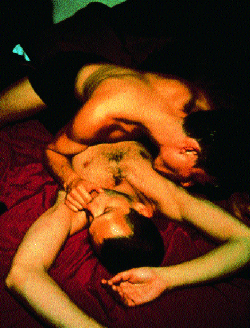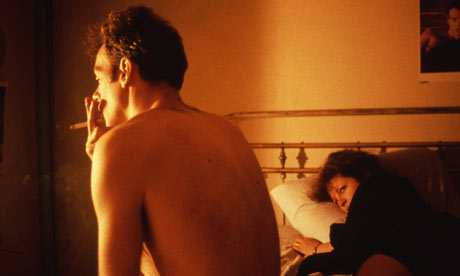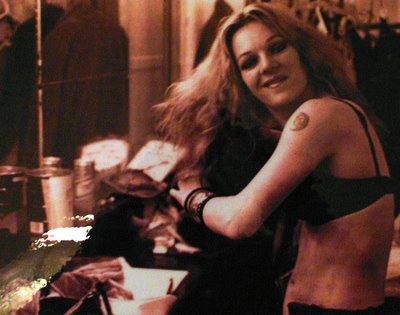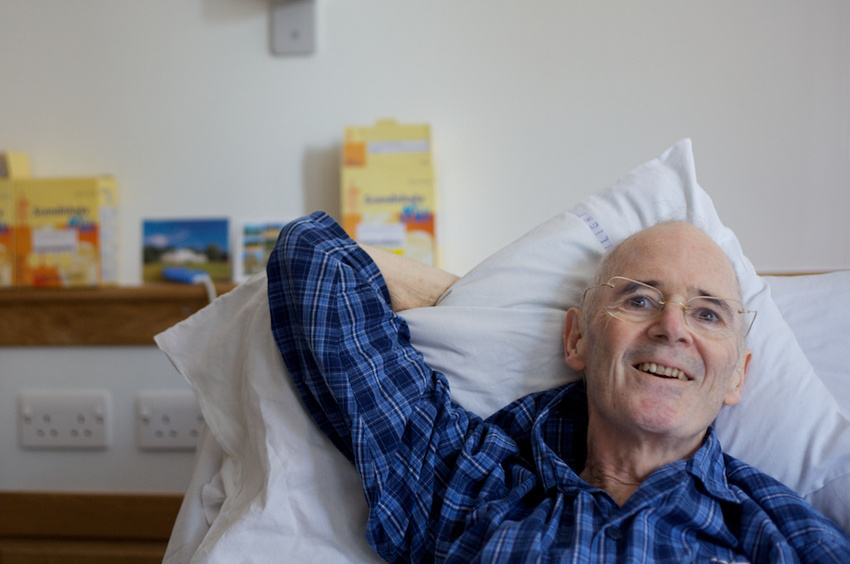Joshua’s younger sister, Rosa is currently studying on a Foundation Art course at Oxford Brookes University. We are reproducing here an essay she has written as part of her course which explores the themes of photography and death and the way we use the medium as a way of creating memorials to people’s lives. In this essay Rosa posits some very challenging questions – how far, she asks, is the act of taking someone’s photograph a subconscious attempt “to protect ourselves for when that person dies?” To answer this she examines the work of  three very different artists – the American photographer Nan Goldin who captured some of the most intimate and moving images from New York’s gay scene of the 1970’s and 80’s – London based photographer Briony Campbell’s whose “The Dad Project” was a way of saying goodbye with her camera to her father as he lay dying from cancer – and the work  I have produced since Josh’s death, in particular my book “Released”.
I am seriously moved by Rosa’s ability and her desire to use her university projects as a way of understanding what her own work now means in the light of Joshua’s death and for being prepared to share those thoughts with us. Â Â (Jimmy)
Making it Real – Death and Photography
In my essay I will be exploring how we take photographs of loved ones with the possibly subconscious aim to memorialise that person after they have died and look at the ways in which we can turn found photos of a lost loved one into prominent memorials of their life.
How far is taking a photograph of someone a response to our fear of death? Is their fear their fear or is it ours? What power does the photograph hold? Does it comfort us in our grief and why? When images of death are all around us, why do we shy away from post-mortem images of people we have known and loved?
I will be structuring the essay around the three stages of taking images as a memorial that I have concluded from some of my research:
-Â Â Â Â Â Taking images before someone has died, when they are certainly alive and healthy yet, with the subconscious idea that the photograph will almost certainly outlive them.
-Â Â Â Â Â Taking images of someone as they physically die, a concept that is almost unheard of in our culture. I ask could this be a way of helping us prepare for their death?
-Â Â Â Â Â Finally, taking and using images of the person after they have died.
NAN GOLDIN – keeping the memory alive
For a long time the work of New York photographer, Nan Goldin has inspired and influenced my own work. She takes very personal and intimate images of her close friends. She photographs them relaxing at their houses, their drug use and abuse and during sex. Nan Goldin’s body of work is often very shocking to the greater public and has frequently acted as an expose of life during the AIDS epidemic. She recorded some of the most intimate moments of herself and of her friends’ lives.
Goldin grew up in Boston, “in the very middle†of a middle class neighbourhood. When Nan was 11 her older sister who was 18 committed suicide. In Goldin’s documentary film, ‘I’ll be your mirror’, she implies that her sister’s death was a catalyst not just for her photography in general but also for the intimate and personal style of her images.
 After leaving college she moved to New York’s lower East Side where she began documenting the post ‘stonewall’ gay scene of the late seventies –“instead of dying at 18, I started to photograph.†Goldin now acknowledges that her sister’s untimely death really shaped her photography in a very subconscious way. She reflects on her photography in the documentary commenting that she “became obsessed with never losing the memory of anyone againâ€. The irony of course was that by the 1990’s many of her subjects were dead either from aids or from drug overdoses. Goldin’s photographs use an intimate snapshot aesthetic and read rather like a private diary made public. The images all show real moments and real people and let the viewer into her life.
After leaving college she moved to New York’s lower East Side where she began documenting the post ‘stonewall’ gay scene of the late seventies –“instead of dying at 18, I started to photograph.†Goldin now acknowledges that her sister’s untimely death really shaped her photography in a very subconscious way. She reflects on her photography in the documentary commenting that she “became obsessed with never losing the memory of anyone againâ€. The irony of course was that by the 1990’s many of her subjects were dead either from aids or from drug overdoses. Goldin’s photographs use an intimate snapshot aesthetic and read rather like a private diary made public. The images all show real moments and real people and let the viewer into her life.
Iniatially Goldin took photographs for her personal use. But do portraits taken as a commission or for more public viewing  have the same ‘death instinct’? British photographer David Bailey believes they do: “Photography is all about death really… you look at [old] pictures-they’re always dead. You don’t look at a painting and think ‘she’s dead’ but you look at a photograph and think ‘she’s dead!’
Do we all take photographs of the people that we love to capture them in case of death or to protect ourselves for when that ‘subject’ dies? When you are taking an image of a loved one it transforms from just a photograph into a memory, a character and a relationship. This is the element for me, which makes the works of artists such as Goldin so significant and so beautiful.
Cookie Mueller – 1981
‘The Cookie Portfolio’ as Goldin names it, is a series of fifteen photographs taken over thirteen years of Cookie Mueller – “the starlet of the Lower East Side†and the “queen of the downtown social sceneâ€. The images illustrate Cookie’s character and vitality yet also captures her deterioration and eventual death from AIDS in 1989.
“I used to think that I could never lose anyone if I photographed them enough. I put together this series of pictures of Cookie from the 13 years I knew her in order to keep her with me. In fact they show me how much I’ve lost.â€
“The Cookie Portfolio†is an excellent example of the way a photographic record of anyone can come to have such a power after they have died.
Goldin’s dilemma highlights a basic contradiction in all photographic portraits especially those of people who have then died; their photograph has an incredible likeness of being to the subject, it invites us to accept consolation from their living image yet, it can also a painful reminder that they are now gone.
The last image in Goldin’s Cookie Portfolio is of Cookie in her coffin. It is extraordinary that in a series of photographs intended to keep the memory of her friend alive that she would include a photograph of her corpse.
Extraordinary not just because of Goldin’s fear of losing her friends ‘living’ memory, but more because in her life and her art she is surrounded by the deaths of those close to her yet, this picture of Cookie in her coffin is one of only a very few she has published of a dead friend. Sex, drugs, deviance, yes – death, no.
However, rewind to the nineteenth century and images of dead people, especially babies, were very common, socially accepted and even valued. At this time, infant mortality was very high and a lot of the time there wouldn’t be enough time to make a photograph of the child before it had died. So the families would photograph the deceased openly and unfortunately this occurred often as in those days infant death was more commonplace.
While images of death as part of our daily news intake, such as the killing of Bin Laden, are quite acceptable, people who now want a post-mortem record can face social opprobrium if they were to take a picture or commission someone to do so. People on the television and in the newspapers remain characters and don’t seem to be real people but people don’t want to acknowledge the death of someone close to them by taking a photograph. Similarly, a lot of people live in the mindset that if we don’t acknowledge death by photographing it then maybe it hasn’t happened.
When my own brother Joshua died last year and I went to see his body in the funeral parlour I didn’t take a photograph. It was impossible for me to do so not only because I was using all of my emotional energy to process what was happening leaving no room for the camera, also it simply isn’t the done thing nowadays.
Perhaps for Goldin who lived through her camera and often shielded herself with it, taking the picture of Cookie’s corpse was a necessary confirmation of her death. For me, the support of my family meant that there was no need to record his lifeless form for posterity – above all it was just too painful.
From personal experience I’ve learnt that we tend to shy away from photographs that depict images of the dead especially when the deceased  is a loved one. Yet, it is surprising that in popular contemporary culture, there are still few acceptable ways of recording the rituals surrounding death and mourning process.  When families get together it is often around important moments such as births, marriages and funerals, the latter being the event least photographed. Unlike weddings, there is no industry for funeral photography or videos. This seems strange to me, as death is the only inevitable event in someone’s life. After my brothers death, we as a family collected all the pictures of Josh that we could – a hugely important part of our efforts to come to terms with our loss; these were of course all pictures of Josh alive. Overnight, they had all become memorial photographs – each snapshot acquiring more poignancy… and over time these ‘found’ images of Joshua have gained even more significance being used over and over again: at the funeral, parties, memorial days, and given to people as gifts. For example, the images below were both images which gained significance from their first use as his business card, now as a memento for people to put in their wallets and on their walls to remember Josh. Like Goldin we were using his photograph as a way of keeping Joshua alive.
When families get together it is often around important moments such as births, marriages and funerals, the latter being the event least photographed. Unlike weddings, there is no industry for funeral photography or videos. This seems strange to me, as death is the only inevitable event in someone’s life. After my brothers death, we as a family collected all the pictures of Josh that we could – a hugely important part of our efforts to come to terms with our loss; these were of course all pictures of Josh alive. Overnight, they had all become memorial photographs – each snapshot acquiring more poignancy… and over time these ‘found’ images of Joshua have gained even more significance being used over and over again: at the funeral, parties, memorial days, and given to people as gifts. For example, the images below were both images which gained significance from their first use as his business card, now as a memento for people to put in their wallets and on their walls to remember Josh. Like Goldin we were using his photograph as a way of keeping Joshua alive.
 Above – the photograph Josh used for his business card
Above – the photograph Josh used for his business card
This image was reproduced and given to mourners at Josh’s funeral
Images, like the ones of Josh, seem to become an icon of a person’s life. On the surface we take images to represent memories and relationships but, when a tragedy happens, I have realised that maybe we take images to prematurely memorialise that character and protect ones self from the inevitable. The images grant us with satisfaction by showing an exact visual replication of that person whilst still alive but at the same time the photos will now always be a reminder that they are now not alive.
JIMMY EDMONDS – RELEASED – the photographic illusion
A few weeks later after we received his ashes back from the crematorium, my father, Jimmy Edmonds, started on a photographic project that would be both a memorial to my brother and a record of the way our family was dealing with our loss.

This project was published with the title RELEASED. Â Â It can be seen in full here. Â He started by photographing Josh’s ashes; he captured them pouring through the air and the clouds of dust that they created.
He then experimented with laying the ashes on top of the photograph shown above of Joshua that had gained significance from being used at the funeral and over and over again. When put together, the ashes and the image formed conflicting ideas: on the one hand, we can see Josh alive, with him looking back to us, placing us in an illusion letting us believe that he is still alive, but the ashes tell us that he is most definitely dead.
The thing about a photograph is that even though it captures a moment in time it will almost always outlive its subject matter. My Dad wanted to find a way of making images that more accurately reflected the long process of mourning. Again using a photograph he’d taken of Josh, the one used as his business card, he hand printed them using a nineteenth  century technique that used vegetable juice and sunlight – anthotypes. He then combined these bright red images with the ashes and physically stuck the two together. There is no way to fix an anthotype print – in time they will fade. Over time all that will remain will be the ashes of Josh. Nearly all photographs act as an aide-memoir and as such are deceptive. This series of images speaks more to our current reality of life without Josh.
century technique that used vegetable juice and sunlight – anthotypes. He then combined these bright red images with the ashes and physically stuck the two together. There is no way to fix an anthotype print – in time they will fade. Over time all that will remain will be the ashes of Josh. Nearly all photographs act as an aide-memoir and as such are deceptive. This series of images speaks more to our current reality of life without Josh.
My father was able to use the ashes as a creative material and make some beautiful images not only for the people that knew Josh but also for many people that did not know him. They felt privileged and touched that he had ‘let them in’ to such a tender and normally private part of  our family life by witnessing Josh’s actual ashes as a piece of art.
“All that remains will be – all that remains.â€
BRIONY CAMPBELL – saying goodbye with her camera
My father had time to think about his project – (when someone dies, it is after all forever!). When Briony Campbell’s father was diagnosed with cancer he was told that he had just nine months to live. Briony decided to document this with a series of photographs and an accompanying video called The Dad Project. Unlike Goldin’s work, this was a very much conscious process where both father and daughter collaborated. Each of them had to think carefully about what doing this project would mean for them both:
“I agonised for months over whether I should attempt to photograph our relationship at allâ€.
We learn from her video that for her father the project meant getting to know his daughter in new ways and spending the last of his days doing something worthwhile and productive. For Briony it was more of a way to say goodbye. She was able to use her camera as a medium to do this, but I suspect that at times it was also a way to distance herself from the reality of the situation.
“Each day that brought his imminent death into sharper focus, my project became more of a crutch, and more of a member of the family. When we had nothing to be positive about, the project gave us a way to be productiveâ€
For my father the photographic process he undertook was more of a reflection on my brother’s death once he had already gone. Campbell’s project was of the moment and dealt with the emotions she had as her father was dying. She did not know what was going to happen next or when exactly he would die from his terminal illness:
“When you find out you’re going to lose someone you love you don’t know what the story is, so you really can’t plan how to tell it.â€
When we think of images of a dying family member many people are likely to conjure up stereotypical images associated with death – morbid and painful images that could capture pain, suffering, fear or a variety of other negative emotions associated with death. Of course Campbell’s ‘The Dad Project’ series includes those images. But Campbell also creates a story about love. She does this by creating beautiful photographs in a hopeless situation. The video includes humorous chats with her father and I found myself smiling whilst watching it. Similarly, amongst the heartfelt, painful images are picturesque images of light and colour.
“If it were a painful moment, I tried to make the picture more aesthetically beautifulâ€.
“Today we knew he would die soon. I went outside and looked at the sky while we waited for the ambulance.”
The series contains both pictures of Campbell’s father as well as some self-portraits although, I would argue that the self-portraits are images of her father dying too. I think these are some of the most important images in the series as they show her bravery. To let people see you at your weakest and most vulnerable I find really incredible. In my opinion these self-portraits fuse the series together as they put the whole thing into context by showing not only the experience of the father’s illness but also the impact the illness has on his daughter. This has the result of humanising the whole process. Death here is not a news item, but an everyday occurence.
By taking the images of her father with the conscious aim to memorialise the pictures even before he died, to then take images of herself shows a great understanding and coming to terms with death in general. By photographing herself she is essentially preparing herself for when she dies and exploring this through the images – for me, she is memorialising herself in the images using the same idea of taking a photograph to be there when you are dead.
Most of memorial photography exists of images of smiling people aiming to remember the happy times of a person’s life. Campbell’s work is more of a realistic representation of death and includes photographs that are undoubtedly hard to look at, though the series does also include happy and amusing images. By creating a more rounded view of death and dying, Campbell has somehow reduced the fear that many people have of death. I was able to relate to this by thinking back to the funeral we held for Josh. On the day I felt a bit strange that I wasn’t sad all of the time and I felt quite at ease and cheerful at points through out the day – a lot of our friends said they enjoyed the day and I wouldn’t necessarily disagree.
Part of life is that everyone has to die. It is inevitable. At the very least, The Dad Project, opens a door to people and lets them in to this delicate journey.
What becomes clear is that although all three photographers are responding to their encounter with death in very different ways, they are all using photography as a way of coming to terms with loss. For Goldin, photographing her friends is a kind of insurance policy, creating mementos for when they are no longer here. Campbell documents the journey into death in a truly collaborative way and my father is trying to produce new images from my brothers actual remains. And by confronting death and making it real they all go some way to dispelling our fears.
Rosa Harris Edmonds
April 2012
Links
Keep up to date with what I am doing at university and in my personal projects here and here.
Briony’s film, ‘Saying goodbye with my camera’ can  be seen here.
Briony’s photographs of ‘The Dad Project’ can be seen here.
Jimmy’s ‘Released’ photographs can be seen here.

















